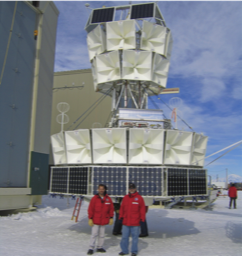 |
Cosmic Ray Group:
- Experimental measurements of the elemental and isotopic composition of heavy cosmic rays
- Experimental measurements of ultra-high energy cosmic rays and neutrinos.
Galactic Cosmic Rays  The SuperTIGER (Super Trans-Iron Galactic Element Recorder) instrument measures the elemental composition of ultra-heavy galactic cosmic-ray (UHGCR) nuclei with atomic number (Z) 26 <= Z <= 40 with high statistical precision and excellent charge resolution and makes exploratory measurements into the 40 < Z <= 60 range. SuperTIGER had a record breaking 55-day balloon flight over Antarctica in December 2012 – January 2013. Data collected from this flight has shown that cosmic ray nuclei that form dust grains in space (refractory elements) are preferentially accelerated to cosmic ray energies over volatile elements by about a factor of 4. The measured abundances are consistent with a cosmic ray source that is a mix of massive star material and normal interstellar material. We are planning to fly ST for a second time in December, 2018 from Antarctica. Data from this flight will be used to improve element abundance measurements for nuclei with Z<40 and to make preliminary measurements of nuclei up through barium (Z=56). SuperTIGER is a collaboration of scientists from Washington University (PI Institution), Goddard Space Flight Center, Caltech/JPL, and the University of Minnesota. |
Galactic Cosmic Rays  The Cosmic Ray Isotope Spectrometer (CRIS), which is aboard the NASA Advanced Composition Explorer (ACE) spacecraft, is designed to measure the elemental and isotopic abundances of galactic cosmic rays heavier than Lithium. These measurements enable us to obtain source abundances and energy spectra (~50 to 600 MeV/nucleon) for the primary nuclei. ACE was launched in 1997 into an orbit around the L1 libration point which is outside the Earth’s magnetosphere. The CRIS experiment continues to return excellent quality data. Ongoing work at Washington University is aimed at measuring the elemental and isotopic abundances of elements heavier than Copper and studying models of cosmic-ray propagation that will enable us to obtain source abundances. This research is being conducted by a collaboration of scientists from Caltech (PI Institution), the Jet Propulsion Laboratory, Goddard Space Flight Center, and Washington University. For more details go to the ACE website. |
Cosmic Rays and Neutrinos  Garry Simburger and Dana Braun standing in front of the Antarctica Impulsive Transient Antenna (ANITA) which is used to investigate high-energy neutrinos and the origin of galactic cosmic-ray nuclei. The Antarctic Impulsive Transient Antenna (ANITA) instrument is designed to detect neutrinos with energies > 10^18 eV and to measure the energy spectrum of ultra-high energy cosmic rays. It has been flown four times on high-altitude balloons over Antarctica. From data obtained on these flights we have obtained an upper-limit on the high-energy neutrino abundance for E>10^18 eV and discovered a new modality for the detection of UHECRs based on synchrotron emission. The PI institution for this experiment is the University of Hawaii. The experiment is being performed by a collaboration of experimenters from a number of universities. For more details go to the ANITA website. |
 The figure above shows a cross-section of the instrument with a simulated shower. The CALorimetric Electron Telescope (CALET) is an instrument designed with the principal objective of measuring the energy spectrum of electrons up to energies of ~5 GeV/nucleon. In addition to electrons, CALET also measures abundances and energy spectra of nuclei up to atomic number Z=28 and abundances of ultra-heavy nuclei as heavy as zirconium (Z=40). It was launched to the International Space Station (ISS) in 2015 and has been taking data since that time. Washington University’s principal effort has been in the measurement of the ultra-heavy nuclear component of cosmic rays. For more details go to the CALET-US website. |
